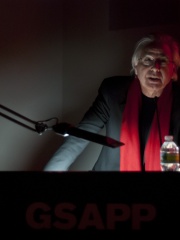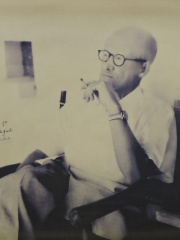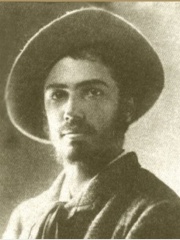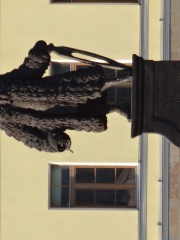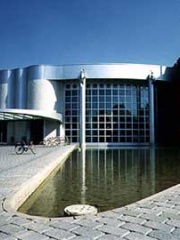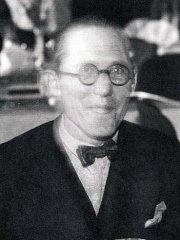

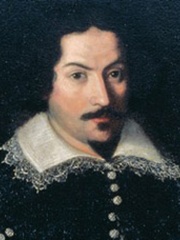
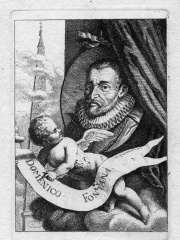
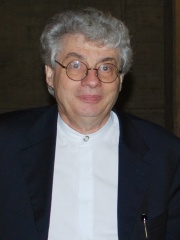
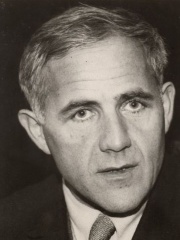
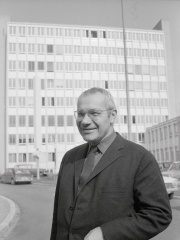
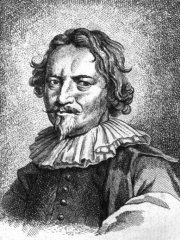
The Most Famous
ARCHITECTS from Switzerland
This page contains a list of the greatest Swiss Architects. The pantheon dataset contains 518 Architects, 17 of which were born in Switzerland. This makes Switzerland the birth place of the 9th most number of Architects behind Austria, and Russia.
Top 10
The following people are considered by Pantheon to be the top 10 most legendary Swiss Architects of all time. This list of famous Swiss Architects is sorted by HPI (Historical Popularity Index), a metric that aggregates information on a biography's online popularity. Visit the rankings page to view the entire list of Swiss Architects.

1. Le Corbusier (1887 - 1965)
With an HPI of 86.85, Le Corbusier is the most famous Swiss Architect. His biography has been translated into 169 different languages on wikipedia.
Charles-Édouard Jeanneret (6 October 1887 – 27 August 1965), known as Le Corbusier, was a Swiss-French architectural designer, painter, urban planner and writer who was one of the pioneers of what is now regarded as modern architecture. He was born in Switzerland to French-speaking Swiss parents, and acquired French nationality by naturalization in 1930. His career spanned five decades, in which he designed buildings in Europe, Japan, India, as well as North and South America. He considered that "the roots of modern architecture are to be found in Viollet-le-Duc." Dedicated to providing better living conditions for the residents of crowded cities, Le Corbusier was influential in urban planning, and was a founding member of the Congrès International d'Architecture Moderne (CIAM). Le Corbusier prepared the master plan for the city of Chandigarh in India, and contributed specific designs for several buildings there, especially the government buildings. In 2016, seventeen projects by Le Corbusier in seven countries were inscribed in the list of UNESCO World Heritage Sites as The Architectural Work of Le Corbusier, an Outstanding Contribution to the Modern Movement. Le Corbusier remains a controversial figure. Some of his urban planning ideas have been criticized for their indifference to pre-existing cultural sites, societal expression and equality, and his alleged ties with fascism, antisemitism, eugenics, and the dictator Benito Mussolini have resulted in some continuing contention. Le Corbusier also designed well-known furniture such as the LC4 chaise longue and the LC1 chair, both made of leather with metal framing.

2. Francesco Borromini (1599 - 1667)
With an HPI of 77.11, Francesco Borromini is the 2nd most famous Swiss Architect. His biography has been translated into 60 different languages.
Francesco Borromini (, Italian: [franˈtʃesko borroˈmiːni]), byname of Francesco Castelli (Italian: [kaˈstɛlli]; 25 September 1599 – 2 August 1667), was an Italian architect born in the modern Swiss canton of Ticino who, with his contemporaries Gian Lorenzo Bernini and Pietro da Cortona, was a leading figure in the emergence of Roman Baroque architecture. A keen student of the architecture of Michelangelo and the ruins of Antiquity, Borromini developed an inventive and distinctive, if somewhat idiosyncratic, architecture employing manipulations of Classical architectural forms, geometrical rationales in his plans, and symbolic meanings in his buildings. His soft lead drawings are particularly distinctive. He seems to have had a sound understanding of structures that perhaps Bernini and Cortona lacked, as they were principally trained in other areas of the visual arts. He appears to have been a self-taught scholar, amassing a large library by the end of his life. His career was constrained by his personality. Unlike Bernini who easily adopted the mantle of the charming courtier in his pursuit of important commissions, Borromini was both melancholic and quick in temper, which resulted in his withdrawing from certain jobs. His conflicted character led him to a death by suicide in 1667. Probably because his work was idiosyncratic, his subsequent influence was not widespread, but it is apparent in the Piedmontese works of Guarino Guarini and, as a fusion with the architectural modes of Bernini and Cortona, in the late Baroque architecture of Northern Europe. Later critics of the Baroque, such as Francesco Milizia and the English architect Sir John Soane, were particularly critical of Borromini's work. From the late nineteenth century onward, however, interest has revived in the works of Borromini and his architecture has become appreciated for its inventiveness.

3. Carlo Maderno (1556 - 1629)
With an HPI of 73.83, Carlo Maderno is the 3rd most famous Swiss Architect. His biography has been translated into 44 different languages.
Carlo Maderno or Maderna (1556 – 31 January 1629) was an Italian architect, born in today's Ticino, Switzerland, who is remembered as one of the fathers of Baroque architecture. His façades of Santa Susanna, St. Peter's Basilica, and Sant'Andrea della Valle were of key importance in the evolution of the Italian Baroque. He often is referred to as the brother of sculptor Stefano Maderno, but this is not universally agreed upon.

4. Domenico Fontana (1543 - 1607)
With an HPI of 70.50, Domenico Fontana is the 4th most famous Swiss Architect. His biography has been translated into 37 different languages.
Domenico Fontana (1543 – 28 June 1607) was an Italian architect of the late Renaissance, born in today's Ticino. He worked primarily in Italy, at Rome and Naples.
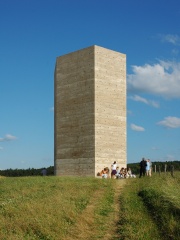
5. Peter Zumthor (b. 1943)
With an HPI of 70.10, Peter Zumthor is the 5th most famous Swiss Architect. His biography has been translated into 41 different languages.
Peter Zumthor (German pronunciation: [ˈpeːtɐ ˈtsuːmtoːɐ̯]; born 26 April 1943) is a Swiss architect whose work is frequently described as uncompromising and minimalist. Though managing a relatively small firm and not being a prolific architect, he is the winner of the 2009 Pritzker Prize and 2013 RIBA Royal Gold Medal.

6. Mario Botta (b. 1943)
With an HPI of 69.76, Mario Botta is the 6th most famous Swiss Architect. His biography has been translated into 38 different languages.
Mario Botta (born 1 April 1943) is a Swiss architect. At age fifteen, Botta dropped out of secondary school and apprenticed with the architectural firm of Carloni and Camenisch in Lugano. After three years, he went to the Art College in Milan for his baccalaureate, and then to Università Iuav di Venezia for his professional degree in 1969. During his time in Venice, Botta got to meet and work with architects Carlo Scarpa, Louis Kahn and Le Corbusier. Botta started his own architectural practice in Lugano in 1970.

7. Hannes Meyer (1889 - 1954)
With an HPI of 66.32, Hannes Meyer is the 7th most famous Swiss Architect. His biography has been translated into 26 different languages.
Hans Emil "Hannes" Meyer (18 November 1889 – 19 July 1954) was a Swiss architect and second director of the Bauhaus Dessau from 1928 to 1930.

8. Max Bill (1908 - 1994)
With an HPI of 65.37, Max Bill is the 8th most famous Swiss Architect. His biography has been translated into 26 different languages.
Max Bill (22 December 1908 – 9 December 1994) was a Swiss architect, artist, painter, typeface designer, industrial designer and graphic designer.

9. Carlo Fontana (1638 - 1714)
With an HPI of 64.56, Carlo Fontana is the 9th most famous Swiss Architect. His biography has been translated into 25 different languages.
Carlo Fontana (1634/1638–1714) was an Italian architect originating from today's Canton Ticino. He was partly responsible for the classicizing direction taken by Late Baroque Roman architecture.
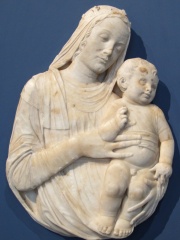
10. Pietro Lombardo (1435 - 1515)
With an HPI of 63.63, Pietro Lombardo is the 10th most famous Swiss Architect. His biography has been translated into 23 different languages.
Pietro Lombardo is also the Italian version of the name of the theologian Peter Lombard. Pietro Lombardo (1435–1515) was an Italian Renaissance sculptor and architect; born in Carona (Ticino), he was the father of Tullio Lombardo and Antonio Lombardo. In the late 15th century, Pietro Lombardo sculpted many Venetian tombs with the help of his sons. These tombs included those of Dante Alighieri, Doge Pasquale Malipiero and Pietro Mocenigo. He was the architect and chief sculptor for the Church of Santa Maria dei Miracoli, Venice (1481–1489) and of San Giobbe in Venice. He also depicted saints and the Virgin Mary on the walls of several Catholic churches. Pietro Lombardo is mentioned in line 27 of Canto XLV by Ezra Pound as the first in a list of Italian renaissance artists whom Pound admired.
People
Pantheon has 17 people classified as Swiss architects born between 1230 and 1944. Of these 17, 3 (17.65%) of them are still alive today. The most famous living Swiss architects include Peter Zumthor, Mario Botta, and Bernard Tschumi. The most famous deceased Swiss architects include Le Corbusier, Francesco Borromini, and Carlo Maderno.
Living Swiss Architects
Go to all RankingsPeter Zumthor
1943 - Present
HPI: 70.10
Mario Botta
1943 - Present
HPI: 69.76
Bernard Tschumi
1944 - Present
HPI: 63.28
Deceased Swiss Architects
Go to all RankingsLe Corbusier
1887 - 1965
HPI: 86.85
Francesco Borromini
1599 - 1667
HPI: 77.11
Carlo Maderno
1556 - 1629
HPI: 73.83
Domenico Fontana
1543 - 1607
HPI: 70.50
Hannes Meyer
1889 - 1954
HPI: 66.32
Max Bill
1908 - 1994
HPI: 65.37
Carlo Fontana
1638 - 1714
HPI: 64.56
Pietro Lombardo
1435 - 1515
HPI: 63.63
Pierre Jeanneret
1896 - 1967
HPI: 62.56
Adolphe Appia
1862 - 1928
HPI: 61.35
Domenico Trezzini
1670 - 1734
HPI: 60.79
Justus Dahinden
1925 - 2020
HPI: 57.82
Overlapping Lives
Which Architects were alive at the same time? This visualization shows the lifespans of the 7 most globally memorable Architects since 1700.

